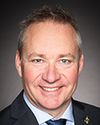Similar to some of the other questions around the understanding of the health dimensions of the virus, that's not our area of expertise at Transport Canada. We defer to our colleagues at the Public Health Agency of Canada. We're working with them to provide information to the airlines. Right now, 10 airlines are flying directly from China to Canada. We're working with them to share information on how to properly groom and clean the aircraft for this very reason. It's hard for us to speak to the effectiveness of that, because in terms of the health aspect, we defer to our colleagues at the Public Health Agency of Canada.
If you'll give me licence, I'll add a response to your first question. In the marine mode, we require vessels to report in to Transport Canada—to our marine security operations centres, where we work with CBSA, the Coast Guard and other agencies—96 hours before arrival. For those vessels that are coming from China or that had stops in China, about 22 of which are on their way to Canada now, we've instructed them to provide us with additional information, similar to what's being asked at the land border, so that we can gather that information, share it with our colleagues at the Public Health Agency of Canada, and do an assessment of the crews coming in to address the issue about their coming in on a non-aviation mode.




